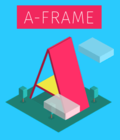A-Frame (virtual reality framework)
 | |
| Developer(s) | Diego Marcos, Don McCurdy, Kevin Ngo |
|---|---|
| Initial release | December 2015 |
| Stable release | 1.0.4
/ February 5, 2020 |
| Repository | |
| Written in | JavaScript |
| Platform | Cross-platform |
| Type | JavaScript framework |
| License | MIT License |
| Website | aframe |
A-Frame is an open-source web framework for building virtual reality (VR) experiences.[1] It is maintained by developers from Supermedium (Diego Marcos, Kevin Ngo) and Google (Don McCurdy). A-Frame is an entity component system framework for Three.js where developers can create 3D and WebVR scenes using HTML. HTML provides a familiar authoring tool for web developers and designers while incorporating a popular game development pattern used by engines such as Unity.
History
A-Frame was originally developed within the Mozilla VR team during mid-to-late 2015.[2] A-Frame was created in order to allow web developers and designers to author 3D and VR experiences[3] with HTML without having to know WebGL.[4] A-Frame's first public release was on December 16, 2015.[5] On December 16, 2019 A-Frame version 1.0.0 was released.[6]
Community
All online IDEs support A-Frame as a result of being based on HTML. Documentation is available for the API.[7] Support for developers committing to the library is provided via GitHub issues, while support for developers building apps and web pages is provided via StackOverflow.[8] Real-time on-line support is provided via Slack.[9] Most of the developers are also on Twitter[citation needed].
Usage
Mozilla Hubs Chat room software uses A-Frame.[10]
See also
References
- ^ "A-Frame". A-Frame. Retrieved 2016-10-25.
- ^ "Introducing A-Frame: Building Blocks for WebVR". Mozilla VR Blog. 2015-12-16. Retrieved 2016-10-26.
- ^ Lang, Ben (2015-12-16). "Mozilla A-Frame: WebVR Starting With One Line of Code". Road to VR. Retrieved 2016-10-25.
- ^ "Mozilla makes it easy to create VR websites with 'A-Frame'". Engadget. Retrieved 2016-10-25.
- ^ "Mozilla Releases A-Frame WebVR Framework". AR VR Magazine. 2015-12-18. Retrieved 2016-10-25.
- ^ "A-Frame v1.0.0 - WebXR Support, AR Mode". A-Frame. Retrieved 30 March 2020.
- ^ "Introduction — A-Frame". aframe.io. Retrieved 2016-10-25.
- ^ "Newest 'aframe' Questions". stackoverflow.com. Retrieved 2016-10-25.
- ^ Slack. "Slack". aframe.io. Retrieved 2016-10-25.
- ^ "mozilla/hubs". Mozilla. 29 March 2020. Retrieved 30 March 2020.
